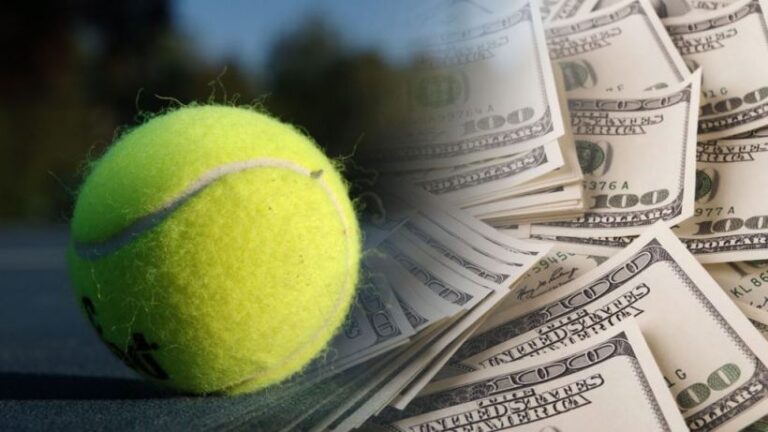Among U.S.-based sports bettors, tennis doesn’t receive nearly the same level of attention as football, basketball, baseball, hockey, or even golf. In my opinion, overlooking the potential tennis has for sports bettors is a mistake that is committed at an alarming rate.
During the long summer months, sports options dwindle before football picks up in September. Until then, it’s just (primarily) baseball, golf, and tennis and not much else. As a bettor, shouldn’t you try to profit from betting on all three? In this article I’ll cover 5 factors that you should look for when betting on tennis.
1 – The Court Surface
When you talk about the differences in the playing surface, typically the discussion involves talking about turf vs. grass. In some cases, such as football (the difference between a turf field and a real grass field on a rainy day in December is significant), the playing surface has major implications. In other cases, like with baseball, for example, it’s not really a big deal either way.

Note:
Tennis, if you’re entirely unfamiliar with the sport, is played on three surfaces: the hard court (what you’ll likely see at your local park), clay courts (you’ll recognize these on ESPN with their bright orange/brown color), and grass courts (these are almost exclusively at Wimbledon).
Of course the greatest players in the game are able to perform at a high level on all surfaces, but some court types fit better with their game than others. For example, Novak Djokovic is one of the best hard court players of all time, and certainly the best in the game today. Federer, on the other hand, has shown a particular dominance when it comes to the grass courts at Wimbledon. When it comes to the clay courts, Nadal is the undisputed best player in that area.
Now, it’s important to remember that what I laid out in the paragraph above is fairly common knowledge among tennis enthusiasts, so you might not be able to get much of an edge at the sportsbooks. With that being said, being a good sports bettors starts with knowing the sports you’re betting on, and this is square one for those who are new to betting tennis matches.
2 – Health Status
Even without the hard hits that are seen in sports like football, hockey, and basketball, injuries happen fairly among tennis pros. The repeated motion involved with swinging the racket, combined with the wear and tear of running around and changing direction for several hours at a time, means even the fittest athletes in the sport break down from time to time.
Before betting on any individual going into a tennis match, your first order of business should be to research their current health status. Sometimes little injuries might not make headline news, and if you’re not plugged into the sport at all times it’s easy to overlook something that might actually have a big impact on the outcome of a match.
Note:
The good news is that there are plenty of resources at your disposal that are there to help you make well-informed decisions. For example, if you notice that a top-tier player has a nagging knee injury that isn’t going to keep them out of the tournament but will likely hurt their game on the court, you may want to consider playing the odds and taking the underdog.
Sportsbooks might account for injuries when they put out the opening odds, but if the public isn’t aware, it could push things in a different direction. Remember, betting markets are run by public action – not oddsmakers.
Above all, you don’t want to become a victim of your own laziness by neglecting to do the research before putting in a bet. Everyone has been there at one point or another, and it rarely works out in your favor when you don’t put in the time to get all the relevant information.
3 – The Betting Odds Offered
Becoming a good tennis bettor isn’t just about understanding the game on the court – it’s also crucial to consider the numbers at the sportsbook. No matter the sport (and this even applies to bets that aren’t sports-related), if you want a sustainable strategy that will pay off in the long run, value is the name of the game.
Plenty of different bet types are going to be offered by most sportsbooks (more on those in the next section). It’s on you to find which plays are the highest-value, meaning which plays have the most favorable risk-reward scenario.

You might think it’s a safe bet to put your money on the heavy favorite, but if you’re not careful you could put yourself in a hole in a hurry. You don’t want to be in a position where you have to wager significantly more money than you stand to win if your bet hits. Remember that there’s no such thing as a “safe bet,” and sportsbooks make a killing off of inflated odds on the players that the public considers the most likely to win. This applies to all sports, but especially individual sports where there’s only one winner in a field comprised of dozens of players.
Note:
Personally, I like to package together several players who have a chance to win, but aren’t necessarily at the top of the “favorites” list. That way you have several horses in the race, and if one wins, you’ll more than cover your losses.
One of the challenges that amateur bettors have with this philosophy is that you lost most of the time, which is hard to stomach. Winning 1 out of 10 bets sounds pretty bad, but if that one win was at +1500 odds, you’ll have made quite a bit of money when it’s all said and done.
Generally speaking, it’s beneficial to go against what the public is doing. If the public was good at predicting outcomes, sportsbooks wouldn’t be a billion-dollar industry. Be careful and avoid sacrificing value because you think one of the favorites is a “sure thing” – those just don’t exist in sports.
4 – Know All the Available Betting Options
Nearly all sportsbooks online that have odds on an ATP or WTA event will have a plethora of different bet types. If you don’t like the odds for the outright winner, for example, you might be more inclined to stick to individual matches. Can’t decide on a winner? Perhaps over/under options will give you what you’re looking for.
Note:
Betting on the eventual winner of the tournament is fairly obvious – you see the odds and determine which risk vs. reward looks good to you. The same can be said with individual matches when offered in a straight-up format, but sportsbooks will allow handicappers to place bets with a point spread as well. For example, you can bet on a player who will get (or give) a predetermined amount of games. It might look something like: Pablo Cuevas (-2, -115). That would mean if you bet on Cuevas, he must win by more than two games in order for you to cash in on your bet.
If you don’t have a strong opinion about who’s going to win but do have a feel for how a match is going to play out, you’re in luck with the over/under options. These can be anything from how many games a certain player will win (this is good if you think an underdog is going to perform above expectations against a heavy favorite), to how many total games will be played within the match.

All good bettors review their options before making a wager. Even if you’re new to tennis, there’s no excuse for overlooking all the opportunities the sportsbooks provide.
Conclusion
If you’re like most bettors, your knowledge of tennis isn’t exactly the same as it is with other sports. With that being said, the best way to learn the sport is by having your bankroll depend on it!
As I mentioned previously, the heart of “tennis season” is a slow period on the U.S. sports calendar. Take the time to understand the game and you might even develop an appreciation for the sport – not just as a bettor, but as a sports fan.











